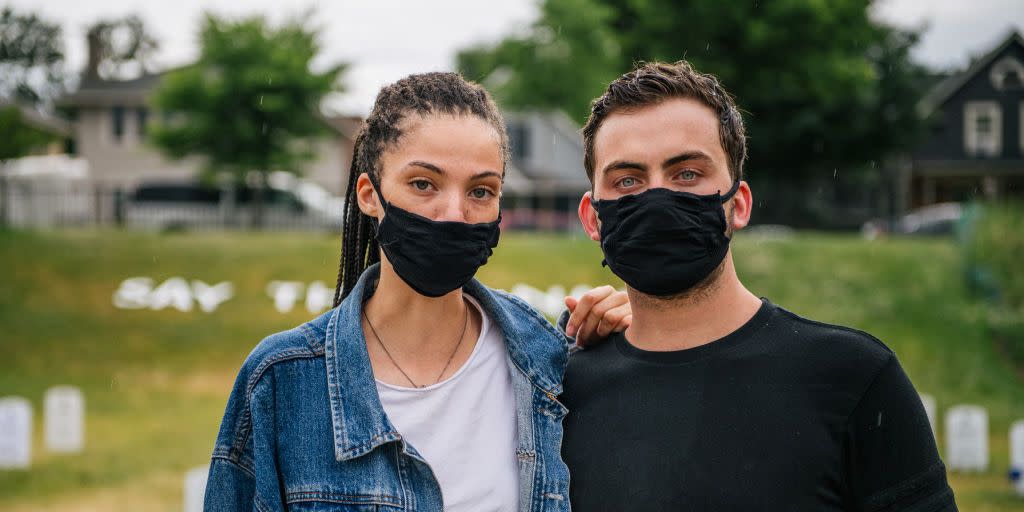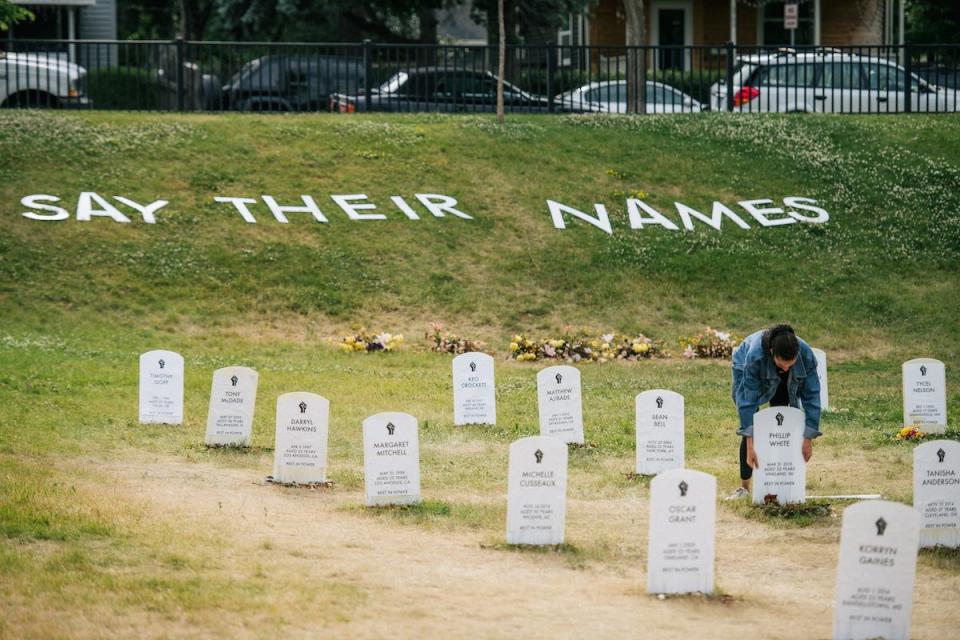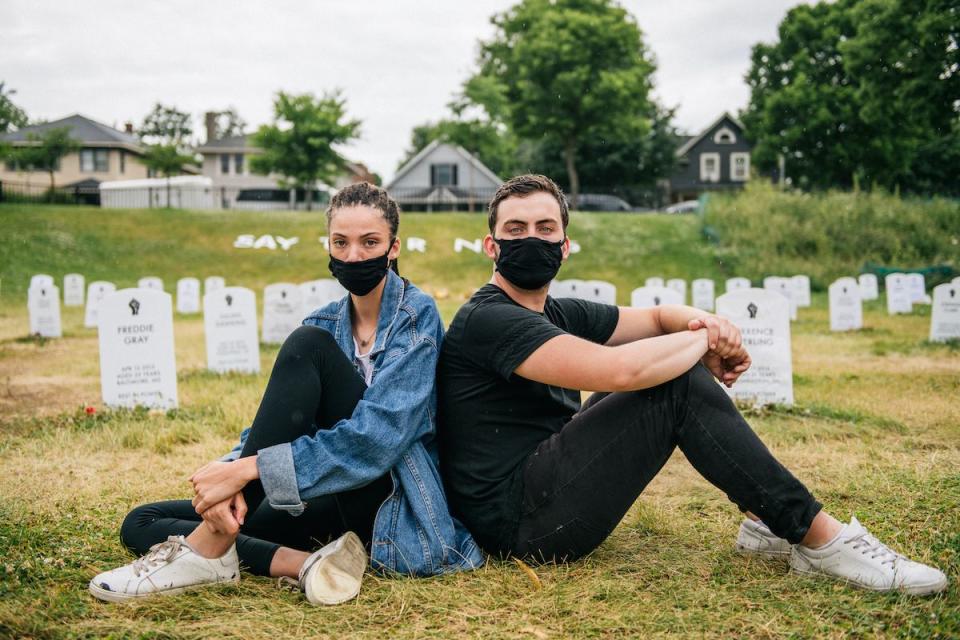A Cemetery in Minneapolis Pays Tribute to Thousands of Black Victims of Police Violence

- Oops!Something went wrong.Please try again later.
On May 25, 2020, Conner Wright and Anna Barber were college students in Philadelphia—where 81 percent of police shooting victims are Black—when the life of yet another unarmed Black man, George Floyd, was taken by police in Minneapolis.
Millions of angry Americans took the streets to protest police violence. Countless artists channeled their rage into profound new works. Wright and Barber did both.
The now University of Pennsylvania graduates flew to Minneapolis days after Floyd was killed to construct a temporary art installation called “Say Their Names,” a visual manifestation of and expansion on the original racial justice hashtag “Say Her Name,” first circulated in 2014 following the death of another police brutality victim, Sandra Bland.
Featuring more than 100 tombstones designed and constructed out of cardboard, plastic, and paper and built over the course of three days, the installation was originally slated to be up for just one weekend. The community, however, pressed for it to remain. “We didn’t expect the response the installation got,” says Wright, a professional muralist since his senior year of high school who has also created large-scale installations for companies like Facebook and the St. Louis Cardinals. “It has been beyond humbling and moving the way the local community has supported it.”

“On the third or fourth day the cemetery was up it was supposed to rain,” recounts Wright. “I remember waking up to an email from a man in the community who said he’d heard it start to rain while he was sleeping, so he got out of his bed at 3:30 in the morning, grabbed as many trash bags as he could find, and ran to the field to protect as many of the paper gravestones as he could. Another time,” Wright continues, getting choked up, “we showed up at the cemetery and there was a couple out there on their hands and knees staking metal stakes into the ground to support the gravestones because we had used wooden ones and the rain had caused them to deteriorate. They, too, were moved to help protect what had become a sacred space.”
George Floyd’s family visited, as did the families of other victims. Soon after the symbolic cemetery remembering Sean Bell, Breonna Taylor, and others was installed, Wright and Barber received hundreds of requests from families across the country to add their loved ones' names to it, leading to their more than month-long stay in Minneapolis, the addition of 30 more gravestones and a fundraising effort to purchase materials that would help make the beloved installation weather-resistant.
Now, with the second anniversary of Floyd’s brutal death, the pair is petitioning lawmakers to help make permanent the paper cemetery that they and 17 then Minneapolis-area college students built in an open green space off 37th Street in South Minneapolis, just two blocks from where Floyd was murdered, to commemorate the lives of thousands of Black victims of police violence.
“Initially we raised $800 for corrugated plastic to waterproof the paper,” says Barber of the pair’s efforts to preserve their creation, the site of a candlelight vigil attended by hundreds of people in the earliest days of the installation, all participating in an 8 minute and 46 second blindfolded moment of silence in observation of the inhumane manner in which Floyd was killed. ‘Then we were able to raise another $1,000 to have all of the victims’ names printed directly on the plastic so people could read them,” adds the London native, fashion model, and tech entrepreneur, who says she, too, has been deeply touched by the response of the community. “The wife of another victim named Mark Henderson reached out to us and said that she and his two kids couldn't afford a headstone for him and that our cemetery was the only place they could come to mourn him,” she recalls. “On Father's Day, she and their children showed up with flowers, balloons, and Father's Day cards and put them right in front of his grave. And there are so many other stories like this—of families in and outside of Minneapolis coming together to mourn all that we have lost.”
Soon after its creation, "it became clear that we had to do everything in our power to keep it up longer than a weekend," says Barber. "People would remove their hats once they entered the grounds, and step over the areas of grass where bodies would normally be buried. It was clear that what had started as an art installation had taken on the ether of a real cemetery.”

And so, Barber and Wright say, as long as the community fights for the survival of what they created as protest art but that has transformed into a hallowed place, they will, too. “We're petitioning the city for money to replace the paper gravestones with permanent ones, and permission to make the land the cemetery is on its permanent home, but all of this is ultimately the community’s decision, not ours.”
How You Can Help
“If have an interest in the long-term preservation of our cemetery, please reach out to Minneapolis councilwoman Andrea Jenkins at minneapolis311@minneapolismn.gov or Mayor Jacob Frey at mayor.schedule@minneapolismn.gov to voice your support for the funding,” encourages Wright. “And if you wish to provide financial support to the fight for racial equality, you can purchase a limited-edition print of the Say Their Names Cemetery at saytheirnamescemetery.com. All proceeds from print sales go to the Anti-Racism Fund, which provides capital from a pool of donations to a dynamic portfolio of curated organizations whose ethos align with ARF’s mission.
You Might Also Like

